

Every mission has its little offerings to fate to back up the hard work and attention to detail that goes into prepping for launch. While in Japan, the GPM team adopted the Japanese custom of coloring in one eye of a Daruma doll.
I first encountered it when visiting the support control room for the launch dress rehearsal last weekend in the Spacecraft Test and Assembly building at Tanegashima Space Center. Sitting on top of one of the computers was a round, squat, stylized doll. Lisa Bartusek, one of the systems engineers on console for the rehearsal, explained that in Japan, the Daruma doll is often given as a gift of encouragement for working toward a goal. When the goal is set, one eye is colored in. When the goal is achieved, the second eye is colored in.
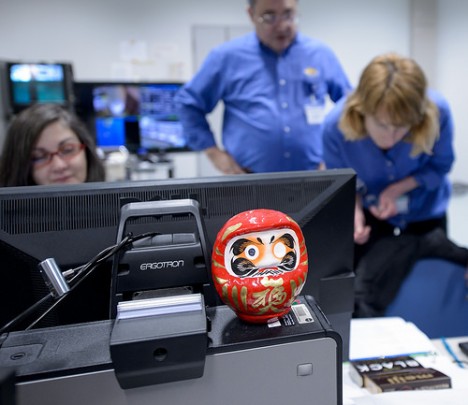
A Daruma doll is seen amongst the NASA GPM Mission launch team in the Spacecraft Test and Assembly Building 2 (STA2) during the all-day launch simulation for the Global Precipitation Measurement (GPM) Core Observatory, Saturday, Feb. 22, 2014, Tanegashima Space Center (TNSC), Tanegashima Island, Japan. Credit: NASA/Bill Ingalls
My reaction to seeing it was that it would definitely motivate me to finish a goal: a doll with only one eye filled in, looking lopsided, would drive me nuts.
The GPM team has several Daruma dolls. The one for the team on console in Tanegashima was for a safe and successful launch. Back at Goddard Space Flight Center in Greenbelt, Md. a second and third Daruma doll sat in the Launch Support Room (LSR) and the Mission Operations Center where the GPM team is runs the mission now that the GPM Core Observatory is in space. For the Goddard team, their goal was to have the GPM Core Observatory separate from the rocket, get communications running, deploy solar arrays and point toward the sun to collect power. Those were the big moments for the team in the hot seat.
Caitlin Bacha on the GPM propulsion team was on console in the LSR at Goddard and wrote to me a few hours after launch. “Wahoo! Success!! I also think it’s funny how many videos have all the cheering after the rocket goes up. In here it was silent. The cheers came 10 min after with acquisition of signal. And again with the solar arrays deployed. Since then it’s been a flurry of activity in the LSR!”

JAXA has a daruma doll, too. One is seen on the desk of Masahiro Kojima, GPM Dual-frequency Precipitation Radar project manager, Japan Aerospace Exploration Agency (JAXA), at the Tanegashima Space Cener’s Range Control Center (RCC), Wednesday, Feb. 26, 2014, Tanegashima, Japan.
After GPM’s successful launch at 3:37 a.m. (JST) on Friday, Feb 28, the team started coloring in the eyes.
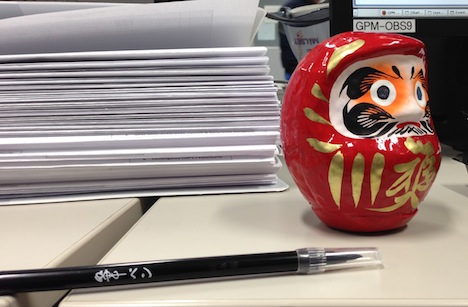
The colored in eye of the Daruma doll in the Tanegashima launch support room, Feb 28 (post-launch JST). Credit: Cody Buell

The Daruma doll in the Mission Operations Center at Goddard Space Flight Center in Maryland, the eye colored in post-solar array deploy, Feb 27 (post-launch U.S. EST). Credit: Eish Patel
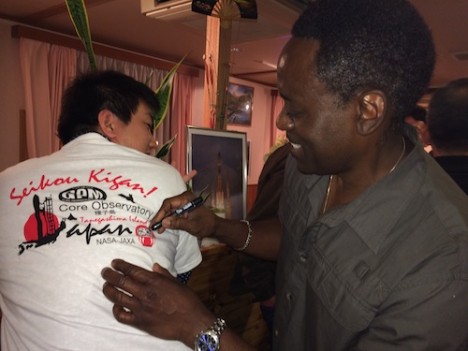
Larry Morgan, quality assurance, fills in the eye of the Daruma doll on the back of a MHI engineer’s t-shirt, Feb 28, Tanegashima, Japan. Credit: Lynette Marbley
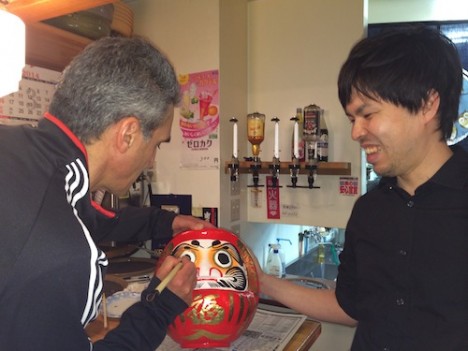
Art Azarbarzin, GPM project manager, fills in the second eye of the JAXA Daruma doll at the party after launch with JAXA engineer Hyakusoku Yasutoshi, Feb 28. Credit: Lynette Marbley
The only one still uncolored is the one in launch support room at Goddard. When I asked for photos after launch, Lisa wrote me that the team at Goddard has extended their goal to include powering up the instruments. The GPM Microwave Imager was turned on Mar. 1. The Dual-frequency Precipitation Radar had its controller turned on as well, and full power-up is scheduled for later in the week.

A Japanese H-IIA rocket, with the NASA-Japan Aerospace Exploration Agency (JAXA) Global Precipitation Measurement (GPM) Core Observatory onboard, is seen launching from the Tanegashima Space Center, Friday, Feb. 28, 2014, Tanegashima, Japan. The GPM spacecraft will collect information that unifies data from an international network of existing and future satellites to map global rainfall and snowfall every three hours. Photo Credit: (NASA/Bill Ingalls)
Launches are something special and this one was was spectacular. We were 3 kilometers (1.9 miles) from the launch pad, the absolute minimum safe distance at the Takesaki Observation Stand. The roof doubles as a tiered deck, and lined up at every available railing was a tripod and a camera.
Since we had arrived a couple days in advance, producer Michael Starobin and photographer Bill Ingalls staked out a prime spot early. Down in front was a giant digital countdown clock, and as the hours and then the minutes ticked by, periodic announcements in Japanese and then English came over the loud speaker.
Global Precipitation Measurement, a mission to study rainfall and snowfall around the world, is my third launch. Since I’d been manning the @NASA_Rain account since 11p.m., my head wasn’t in launch mode right away, even when I joined Michael and Bill out at twenty minutes to go. Bill asked me to push a button for one of his cameras, and I was pre-occupied with that for a bit. There’s only so much staring at the rocket pad I could do before the lure of social media pulled me back in to my phone.
But then the last poll came across the speakers at 8 minutes to launch, and then the relentless countdown by a female voice Japanese began. Then it got real.
Across the distance the rocket was lit up on the pad. The countdown continued, a second voice announcing on top of the first — Observatory on internal power — 30 seconds — my heart started pounding as the adrenaline hit — 15 … 10 … 5 — my eyes were bouncing between the clock and the rocket— 4, 3, 2, 1. Zero.
[youtube 6vJCerH3AfE]
The H-IIA lit up the black of night, bright and beautiful. It was so bright I couldn’t see the rocket at all at first, but then it was rising up and up and up — the rumble reached us some twenty seconds later; you could feel it in your chest — the main engine blazing until it was right overhead. A minute or so in, we could just make out the solid rocket boosters falling away. The rocket kept going, a bright light against the field of stars, going and going for several more minutes until it was just another pinprick in the sky.
Three critical things happen after launch. The first is fairing jettison, when, about four minutes after liftoff, the white nose cone that protects the spacecraft through the atmosphere releases and falls away. Meanwhile, the spacecraft is still attached to the rocket. The second is spacecraft separation, which occurred at a little over 15 minutes. At that point, the rocket was too high to see, so we returned inside to watch it on the telemetry and the camera attached to the rocket.
A whole line of Mitsubishi and JAXA public affairs people were lined up waiting, the press waiting for their reaction. As the only NASA person in the room not holding a camera, the JAXA folks asked me to join them, and we all watched the monitor, waiting for the next minutes to pass. The excitement was high in the room — launch so far had gone flawlessly. Then the black and white rocket cam showed the spacecraft surrounded by black; it had successfully separated and we all grinned and clapped.
A minute later I was back at my computer, checking the @NASA_Rain twitter account, #GPM, and the GPM website for updates, waiting for the next milestone. Solar array deploy complete and collecting power. The GPM Core Observatory was safely in space.
Photos of launch are at NASA HQ Flickr GPM set.
Mission updates are on the front page of www.nasa.gov/gpm
When you’re a three person team out in the field, there’s not always enough time to get it all done.

A Japanese H-IIA rocket with the NASA-Japan Aerospace Exploration Agency (JAXA), Global Precipitation Measurement (GPM) Core Observatory onboard, is seen on launch pad 1 of the Tanegashima Space Center, Friday, Feb. 28, 2014, Tanegashima, Japan. Once launched, the GPM spacecraft will collect information that unifies data from an international network of existing and future satellites to map global rainfall and snowfall every three hours. Photo Credit: (NASA/Bill Ingalls)
We are Launch minus 1 hour. The weather is clear, the rocket is fueled, all systems are GO.
In the press room, reporters are grabbing their hard hats and the cameras and heading up to the roof. I’ll be joining them shortly.
Live launch coverage has started on NASA TV and online at www.nasa.gov/nasatv
Latest mission milestones will be flying thick and fast on www.nasa.gov/gpm
And below is all the coverage Michael, NASA photographer Bill Ingalls, and I have done over the last week.
Go GPM!
Photos!
NASA HQ Flickr
http://www.flickr.com/photos/nasahqphoto/sets/72157641344480584/
Features, Video, and Featured photos
GPM’s H-IIA Rocket Rolls Out to the Launch Pad
The H-IIA rocket with the Global Precipitation Measurement Core Observatory aboard rolled out to Launch Pad 1 at 1:04 p.m. on Feb. 27 (Japan time) at Tanegashima Space Center, Japan. The rocket is scheduled to lift off during a launch window that opens at 3:37 a.m. (JST) on Feb. 28. (1:37 p.m. Feb. 27 EST).
http://www.nasa.gov/content/goddard/gpms-h-iia-rocket-rolls-out-to-the-launch-pad/
Home Stretch for GPM Team in Japan
It’s the home stretch for the GPM engineering team from NASA’s Goddard Space Flight Center, that has been on site at Tanegashima Space Center in Japan.
http://www.nasa.gov/content/goddard/home-stretch-for-gpm-engineering-team-in-japan
GPM: Waiting for Launch
The Global Precipitation Measurement mission’s Core Observatory is poised for launch from the Japan Aerospace Exploration Agency’s Tanegashima Space Center, scheduled for the afternoon of Feb. 27, 2014 (EST).
http://youtu.be/nnjL0AwFu9g
Landsat 8 Eyes Japan, GPM Launch Site
This Landsat 8 satellite image of some southern Japanese islands includes Tanegashima (far right), from where the GPM mission’s Core Observatory is
http://www.nasa.gov/content/goddard/landsat-eyes-japan-gpm-launch-site/
GPM’s Last Stop Before Orbit
Art Azarbarzin, NASA’s Global Precipitation Measurement mission project manager, and Mashahiro Kojima, the Japan Aerospace Exploration Agency’s GPM/DPR project manager, reflect on the long journey the GPM Core Observatory spacecraft has taken to reach its last stop before orbit, the Tanegashima Space Center, Japan.
http://youtu.be/9AnLxge5ONY
GPM: Three Shrine Pilgrimage
Japan Aerospace Exploration Agency (JAXA) team members bow at the Ebisu Shrine, the first shrine in a traditional San-ja Mairi, or Three Shrine Pilgrimage, where the team prays on Tuesday, Feb. 25, 2014 for a successful launch, Tanegashima Island, Japan.
http://www.nasa.gov/content/goddard/gpm-three-shrine-pilgrimage/
Live from Japan: Chatting About NASA’s Next Earth Science Mission
Three days before launch of the Global Precipitation Measurement (GPM) Core Observatory from Tanegashima Space Center in Japan, NASA staff supporting the mission set up shop in the lobby of the Sun Pearl Hotel in nearby Minamitane for a live Twitter Q-and-A to answer questions about the mission and what it will do in orbit.
http://www.nasa.gov/content/goddard/live-from-japan-chatting-about-nasas-next-earth-science-mission
NASA GPM Core Observatory’s Rehearsal Weekend at Tanegashima (also made the front page of www.nasa.gov)
On a small island in southern Japan, a satellite that will measure rain and snowfall over most of the globe prepares for launch.
http://www.nasa.gov/content/goddard/nasa-gpm-core-observatorys-rehearsal-weekend-at-tanegashima/
GPM: Greetings from Minamitame!
This video introduces Minamitame Town, near the Japan Aerospace Exploration Agency’s Tanegashima Space Center, from where the Global Precipitation Measurement mission’s Core Observatory is scheduled to launch on the afternoon of Feb. 27, 2014 (EST).
http://youtu.be/b__X7_u6uDk
GPM: Welcome to Minamitane Town
A sign with a model of the Japanese H-IIB rocket welcomes visitors to Minamitane Town on Saturday, Feb. 22, 2014. Minamitane Town is one of only a few small towns located outside of the Japan Aerospace Exploration Agency’s Tanegashima Space Center, where the launch of an H-IIA rocket carrying the Global Precipitation Measurement Core Observatory will take place in the next week.
http://www.nasa.gov/content/goddard/gpm-welcome-to-minamitane-town/
GPM: Tanegashima Space Center
A full-size model of an H-II rocket is seen at the Japan Aerospace Exploration Agency’s Tanegashima Space Center visitors center a week ahead of the planned launch of an H-IIA rocket carrying the Global Precipitation Measurement Core Observatory, Friday, Feb. 21, 2014, Tanegashima Island, Japan.
http://www.nasa.gov/content/goddard/gpm-tanegashima-space-center/

A dome protected weather radar just south of Minamitane is part of a weather station for Tanegashima Space Center. Feb 23. Tanegashima, Japan. Credit: NASA/Ellen Gray
I hear it was snowing in Maryland last night/today. In my inbox this evening (East Coast morning), I got the boilerplate message that while Goddard Space Flight Center is open on Feb. 26, non-critical and non-emergency personal could telework or take leave to avoid the snowy roads. The GPM team members scheduled to be on console for Thursday’s launch of the Global Precipitation Measurement Core Observatory are definitely critical.
As I write this in Tanegashima, I’ve been listening to a rainstorm blow across the island. Earlier, the wind was so loud outside of the Spacecraft Test and Assembly building where the GPM project offices are that Michael Starobin and I were worried about driving back to the hotel. The roads are narrow and twisty, which is bad enough after dark when we have drive on the opposite side of the road than we do in the States. Fortunately, when we walked outside the heavy rain we feared hadn’t hit yet, but the wind was wind you lean into.
Weather is one of the deciding factors for when a launch actually happens. It’s also the most fickle. Today, the first launch weather report was issued at Tanegashima Space Center at the Launch Readiness Review, the last major review panel of NASA and JAXA officials who gave GPM a go for launch on Feb. 28 (Feb. 27 in the U.S.) with an updated launch window beginning at 3:37 a.m. (1:37 p.m. EST).
Despite the rain here, the weather forecast for liftoff looks good. From the official update: “Weather at T-0 is forecast to be some scattered clouds with light winds, neither of which are expected to affect launch. Winds at launch are forecast to be 13 mph (violation is 47 mph).”
In about 28 hours, we’ll be watching a relatively clear night sky light up.
For those following along at home, live coverage of launch will begin at 12 noon EST on NASA TV. You can watch streaming online at: http://www.nasa.gov/nasatv

The H-IIA rocket that will carry the GPM Core Observatory into space. Here you can see the orange first stage and the silver second stage with the GPM logo on it. Jan. 20, Tanegashima Space Center. Credit: Mitsubishi Heavy Industries
The H-IIA No. 23 rocket that will carry the GPM Core Observatory into space arrived at Tanegashima Space Center on Jan. 20, 2014. The rocket has two stages, a lower first stage that, with the help of two solid rocket boosters, gets it off the ground, and an upper second stage that lights up a few minutes after launch to boost the satellite the rest of the way into orbit. The launch services provider, Mitsubishi Heavy Industries (MHI), immediately began assembling the rocket. On Jan. 22, the GPM team in Tanegashima was invited to participate in a blessing ceremony for the rocket. Lynette Marbley, the Instruments Chief Safety and Mission Assurance Officer for GPM, represented the NASA team.
She wrote to me about her experience. Her responses have been lightly edited for clarity.
Where did the ceremony take place?
The ceremony took place in the Vertical Assembly Building (VAB) at the foot of the rocket as it sits in the platform.
What did the space that the ceremony took place in look like?
I was amazed to see that they had already placed the upper stage onto the lower stage considering it had been less than 48 hours since its arrival. As I looked up to try and see the top of the rocket, I could see the large GPM logo on the upper stage. It was wonderful to see that logo! The work platform that surrounded the rocket was maybe 15 floors tall. I couldn’t see the top of the rocket. The space where we had the ceremony reminded me of the Goddard High Bay in the Building 29/7 complex, except it was taller.

To give you a sense of size, the rocket is about 15 stories tall. Jan 20. Credit: Mitsubishi Heavy Industries
What happened during the ceremony?
When we arrived, a wooden altar was in place in front of the rocket, and two potted trees were on either side of the altar. There were fruits and vegetables already on the altar and some shrubbery with paper tied to it. Next to the altar was a table that had several large bottles of what I believe is the local potato wine called sochu, a large tree branch with paper tied to it, and several smaller branches.
Two rows of chairs were set up several feet in front of the altar with open space behind them. Every company that has a role in this launch had two representatives sit in the chairs. I had an MHI employee sitting behind me to help me through the ceremony. The remaining GPM team members were lined up behind the chairs. I had two lines of GPM folks standing behind me, about 25-30 people per line and by far the biggest group amongst all the companies. JAXA, MHI, NASA, KHI (Kawasaki Heavy Industries), and IHI Aerospace were represented.

The Shinto shrine set up at the base of the rocket and the kannushi, or priest, who led the ceremony. Jan 20, 2014. Credit: Mitsubishi Heavy Industries

GPM team members lined up behind Lynette, seated in the front row, third from the left. Jan 20, 2014. Credit: Mitsubishi Heavy Industries
The Shinto priest was busy preparing for the ceremony and donned his robes to start. As we all took our places in the chairs, we started out standing. The announcer spoke only Japanese and made some opening remarks. The priest was introduced, and the company representatives all had to bow in unison at the start of the ceremony.
The ceremony was broken into several sections with the Shinto priest doing a lot of chanting approaching the altar, bowing, and shaking the large branch in front of the altar and over his shoulders. The room was very quiet. We mostly stood and bowed during certain segments and at other times we sat. His voice was very deep and had a vibrating sound. At one point, he read from a script and I heard the words “GPM” and “rocket” several times. He also mentioned every company in the prayer.
I understand you had an active role — what did you get to do?
[I participated in] the Tamagushi-houten portion of the ceremony.
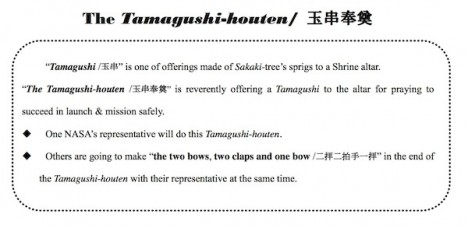
Excerpt from the information packet given to the team before the ceremony. The Tamagushi-houten midway through the ceremony. First the priest cleansed the attendees of evils and invited the god to the alter where he made a sacrifice of food. Then he prayed for the safety of the launch campaign and mission success. Next he blessed the facilities. Then it was time for the Tamagushi-houten when the attendees offer their pure spirits to the god. Finally, the priest withdraws the sacrifice of food and send off the god, and all present bow. Jan 20, 2014. Source: Info provided by MHI
I practiced for several days, and I even looked it up on YouTube to see if I could get a better visual of what to do, which was helpful. I basically took the offering branch from the priest in a specific way and placed it on the altar. After placing it on the alter, I and all NASA team members had to bow twice, clap twice, and bow one more time. I then proceeded back to my seat.

Lynette Marbley placing the offering of Sakaki-tree sprigs on the alter during the blessing ceremony. Jan 20. Credit: Mitsubishi Heavy Indutries
What was the mood like?
It was very quiet and very serious and somber. Everyone was careful not to make a sound. As I looked at other representatives, they were very focused and intense. We all stood at attention with very little movement.
Did you like the ceremony?
I was very nervous but was happy to have had the opportunity to represent NASA. I wanted to make sure I had given the offering properly. Everyone felt I had done a great job, and I have never felt so proud to represent NASA and my country.
In the end, I guess it was fitting that the Safety and Mission Assurance Officer be the one to represent NASA in a ceremony praying for the Safety of the Launch Campaign and Mission Success!